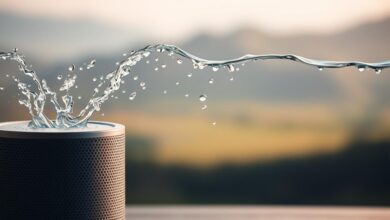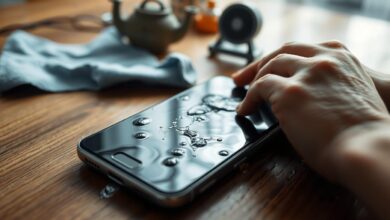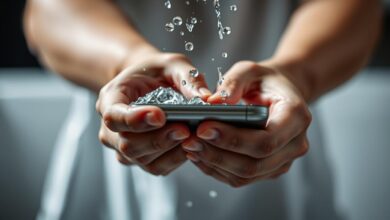how to get water out a iphone

Getting your iPhone wet can really hurt it. Knowing how water damage works and acting fast is key to saving your phone.
If your iPhone gets wet, it might not work right. But, there are ways to fix it. For example, you can use the Water Eject shortcut to get water out of your iPhone’s speakers.
By taking the right steps, you can lessen the damage and restore your iPhone to its best. In this guide, I’ll show you the best ways to fix water damage restoration.
Key Takeaways
- Act quickly to minimize iPhone water damage
- Use the Water Eject shortcut to remove water from iPhone speakers
- Avoid connecting headphones during the drying process
- Turn your volume up to aid in the water ejection process
- Giving your iPhone time to dry out can sometimes resolve the issue
Understanding iPhone Water Damage
Knowing how water damage affects an iPhone is key to saving it. Water can harm different parts of your iPhone. The damage’s extent depends on the water type and how long it stays inside.
How Water Affects iPhone Components
Water can get into your iPhone and damage its inside parts. This includes the logic board and battery. Water can cause short circuits and corrosion, leading to problems or even failure.
Types of Water Damage (Freshwater vs. Saltwater)
The type of water matters a lot. Saltwater is more corrosive than freshwater because of its salt. This can cause more damage. Freshwater can also harm your iPhone, especially if it gets into the internal parts.
| Type of Water | Corrosiveness | Potential Damage |
|---|---|---|
| Freshwater | Low | Short circuits, component damage |
| Saltwater | High | Corrosion, accelerated damage |
Water Damage Indicators on iPhones
iPhones have special indicators for water damage. These indicators change color when they meet water.
By knowing how water affects your iPhone and spotting damage signs, you can act fast. This might help save your device.
Act Fast: Immediate Steps After Water Exposure
When your iPhone gets wet, time is of the essence. Quick action can help avoid lasting damage.
Turn Off Your iPhone Immediately
Turn off your iPhone right away to stop short circuits. Press the power button if it’s on. If it’s off, wait until it’s dry before turning it back on.
Remove Case and Accessories
Take off any cases or accessories to help your iPhone dry faster. This includes SIM cards and other parts.
Wipe External Moisture
Use a soft cloth to wipe your iPhone and remove moisture. Don’t press too hard to avoid pushing water inside.
Proper Wiping Techniques
Use a soft, lint-free cloth to pat your iPhone’s exterior. Stay away from paper towels or anything that could scratch it.
Materials to Use and Avoid
For drying, a microfiber cloth is best. Don’t use hair dryers or put your iPhone in rice, as these can damage it more.
| Material | Recommended |
|---|---|
| Microfiber Cloth | Yes |
| Paper Towel | No |
| Rice | No |
How to Get Water Out a iPhone Using Apple’s Built-in Features
iPhone users can use built-in features to get water out of their devices. Apple’s latest models have special features to remove moisture, especially from speakers.
Using the Water Eject Shortcut
The Water Eject shortcut is a simple way to remove water from your iPhone. It uses sound frequencies to push water out of the speaker grills. To use it, download the Water Eject shortcut from the Shortcuts app gallery.
After installing, just run the shortcut to start the water removal process. It’s important to follow the instructions carefully to avoid damage.
Sound Vibration Techniques
Sound vibration techniques can also help get water out of your iPhone. Certain sounds can dislodge water from the speakers. You can find these sounds in apps or online.
Playing these sounds through your iPhone’s speakers might remove water. It’s a simple yet effective method to try with other techniques.
Water Ejection Apps and Their Effectiveness
Many apps claim to help remove water from iPhones using sound frequencies. But, their effectiveness varies. It’s important to research and read reviews before downloading any app.
Some apps might not work as promised, and a few could even cause harm. So, it’s best to choose well-reviewed apps and be wary of those that seem too good to be true.
By using these built-in features and techniques, iPhone users can take steps to remove water and prevent damage.
Drying Methods That Actually Work
Fixing a water-damaged iPhone often depends on the drying method. When your iPhone gets wet, drying it out right is key. We’ll look at the best ways to dry your iPhone.
Air Drying Technique
Air drying is simple and effective. It means letting your iPhone dry naturally, without heat. To air dry your iPhone, gently pat it dry with a soft cloth.
Key steps for air drying:
- Gently pat the exterior with a soft cloth.
- Leave the device turned off.
- Avoid using heat sources like hair dryers.
Proper Positioning for Effective Drainage
How you place your iPhone affects drying. To help water drain, put it upright or at an angle. This lets water flow out of the ports.
Optimal Environmental Conditions for Drying
The right environment is key for drying your iPhone. Temperature and humidity are important.
Temperature Considerations
The best temperature for drying is 60°F to 80°F (15°C to 27°C). Avoid heat vents and sunlight to prevent damage.
Humidity Factors
Low humidity helps your iPhone dry faster. High humidity slows drying. A dehumidifier can help in humid places.
As Apple Support advises, “If your iPhone gets wet, unplug and don’t charge until it’s dry.” This shows the need for patience and the right drying methods.
| Drying Factor | Ideal Condition |
|---|---|
| Temperature | 60°F to 80°F (15°C to 27°C) |
| Humidity | Low humidity |
| Positioning | Upright or angled for drainage |
By following these tips, you can dry your iPhone well. Remember, patience is key to successful drying.
The Rice Method: Does It Really Work?
Many people try the rice method to fix a water-damaged iPhone. They put the phone in a container of uncooked rice to soak up the water. But does it actually work?
Science Behind the Rice Method
The rice method uses desiccation to dry out the iPhone. Experts debate its effectiveness. Rice can soak up some moisture, but it’s not a sure fix for water damage repair.
The rice grains might not reach all parts of the phone. And the moisture might not get fully absorbed.
Potential Risks to Your Device
Using rice can also harm your iPhone. Rice dust can clog the phone’s ports and cause more damage. It’s hard to dry the phone completely with the rice method.
This can lead to corrosion and harm the phone’s internal parts. Making iphone water damage worse.
Better Alternatives to Rice
There are better ways to dry a wet iPhone than rice. Desiccants like silica gel packets work better and can be used safely. Professional water damage restoration services also offer reliable solutions.
These services use special equipment to dry and fix the phone. They can make your iPhone good as new.
Using Silica Gel and Desiccants
Silica gel and desiccants are great for drying out a water-damaged iPhone. They soak up moisture, perfect for drying your device’s inside parts.
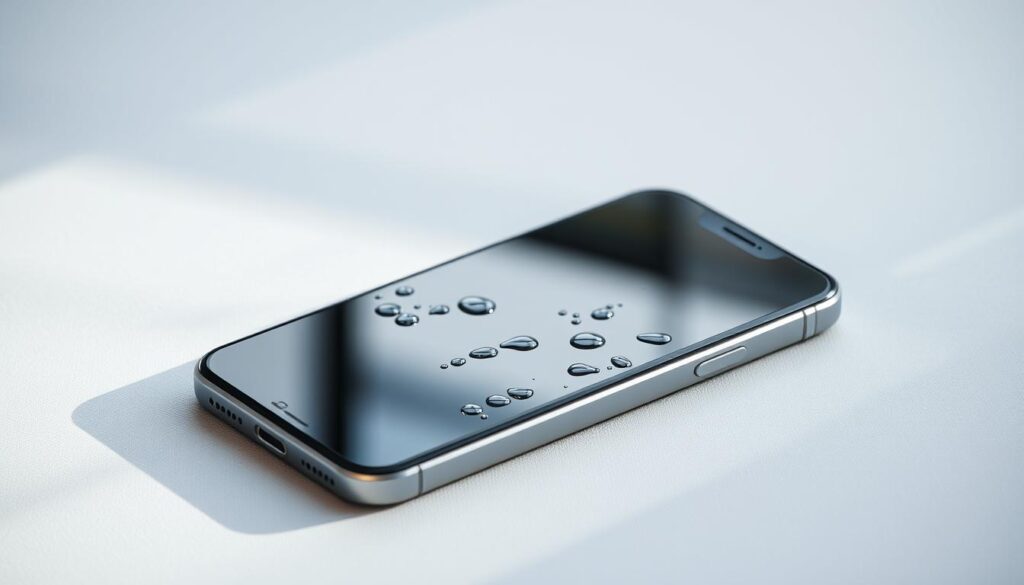
How Desiccants Remove Moisture
Desiccants pull in and hold moisture from around them. Putting your iPhone in a container with desiccants helps dry it. Silica gel, a common desiccant, is especially good because it absorbs a lot.
Creating a Desiccant Chamber
To make a desiccant chamber, you need a container that can seal and enough desiccant. Put desiccants in the container, then place your iPhone on top but not touching the desiccants. Close the container and wait a few days. This lets the desiccants slowly take moisture from your iPhone.
Where to Find Effective Desiccants
You can find silica gel packets in shoe boxes or packaging for electronics. You can also buy desiccants online or at hardware stores. Choose desiccants made for moisture control to dry your iPhone better.
Using silica gel and desiccants can help fix your water-damaged iPhone. It’s a key part of your toolkit for fixing water damage, along with other methods like the rice method.
Removing Water from iPhone Speakers
Water in your iPhone’s speakers can be really annoying. It can cause bad sound quality, distorted audio, or even make the speakers stop working. It’s very important to fix your iPhone’s speakers to keep it working well.
Using Sound Frequencies
Sound waves can help get water out of your iPhone speakers. You can find videos online with sound frequencies made just for this. Playing these sounds softly can help push water out of the speakers. But, don’t play them too loud to avoid damaging your speakers.
Speaker Drainage Techniques
There are other ways to get water out of your speakers too. Try tapping your iPhone gently while it’s facing down. This can help water drain out. You can also use a soft cloth or cotton swab to wipe around the speaker grills carefully.
Testing Speaker Functionality After Drying
After trying to dry your speakers, test if they work. Play some music or a video to see if the sound is better. If the sound is still bad, you might need to try again or get help from a pro. Make sure to check both speakers if your iPhone has them.
By following these steps, you can get water out of your iPhone speakers and make them work again. If you still have problems, it’s best to go to an Apple Store or an authorized service provider for help.
Extracting Water from Charging Ports
Water in your iPhone’s charging port can be a big problem. It stops your phone from charging and can cause more harm if not fixed. Here, I’ll show you how to dry your iPhone’s charging port safely, check for damage, and when to get help from a pro.
Safe Drying Methods for Ports
To dry your iPhone’s charging port, you can use the water ejection feature or tap it gently. You can also use desiccant or silica gel to soak up moisture. If you’re not sure, look up what to do when your iPhone is in water.
Here’s a simple table outlining the drying methods:
| Drying Method | Description | Effectiveness |
|---|---|---|
| Water Ejection Feature | Built-in feature to eject water | High |
| Gentle Tapping | Tapping the port downwards | Moderate |
| Desiccant/Silica Gel | Using moisture-absorbing materials | High |
Signs of Port Damage
After water exposure, check your iPhone’s charging port for damage. Look for corrosion or mineral deposits. If you see damage, fix it quickly to avoid more problems. In bad cases, you might need to get your iPhone fixed by a pro.
When to Attempt Cleaning vs. Professional Repair
If your iPhone’s charging port is clogged or corroded, you have to decide what to do. For small problems, a soft brush or cotton swab might work. But for big damage, it’s best to get a pro to avoid making things worse. Knowing how to fix a water-damaged iPhone is key.
In summary, getting water out of your iPhone’s charging ports needs care and the right steps. By knowing how to dry it safely, spotting damage, and when to get help, you can fix your iPhone’s charging issue.
Different Water Exposure Scenarios
When your iPhone gets wet, the type of water matters a lot. Each scenario needs a different fix to get your phone working again. The damage and how to fix it depend on the water type.
Toilet or Dirty Water Exposure
Dirty water, like from a toilet, is full of harmful stuff. You must act fast to lessen the damage. Clean the outside well and dry the inside with a desiccant. Don’t turn on your iPhone until it’s dry to avoid damage.
Pool or Saltwater Damage
Saltwater, like from a pool, is very bad for your iPhone. Salt can damage the inside parts. Rinse the outside with clean water and dry it with a desiccant or silica gel.
Rain or Fresh Water Exposure
Rain or clean water is less harmful than saltwater or dirty water. Just wipe it down and use a soft cloth to soak up moisture. For extra drying, try a water eject shortcut or sound vibration.
Specific Recovery Steps by Scenario
Every water situation needs a specific fix. First, turn off your iPhone and remove any accessories. Then, use the right drying method for your situation. For saltwater, rinse with fresh water and dry with a desiccant. Always avoid charging your iPhone until it’s completely dry to prevent further damage.
By matching your fix to the water type, you can better fix your water-damaged iPhone. Whether it’s dirty, salt, or fresh water, knowing the right steps is crucial for repair.
Professional Water Damage Repair Options
If your iPhone got wet, knowing your repair options is key. DIY fixes work for small water issues. But, serious damage needs a pro.
Apple Store Services
Apple Stores fix water-damaged iPhones. Prices and steps change based on your iPhone and warranty. AppleCare+ might help with water damage, so check your plan.
Third-Party Repair Services
Third-party shops are cheaper than Apple Stores. But, picking a good one is vital for quality. Look for places with real parts and warranties.
Cost Comparison and Timeframes
Fixing a wet iPhone costs differently at Apple Stores and third-party shops. Here’s a look:
| Service Provider | Cost Range | Repair Timeframe |
|---|---|---|
| Apple Store | $99-$299 | 1-5 business days |
| Third-Party | $50-$200 | Same day to 3 business days |
When picking a repair, think about cost and time. Apple Stores might cost more but offer a warranty and real parts. Third-party shops are cheaper but need careful choice for quality.
AppleCare+ and Water Damage Coverage
AppleCare+ protects your iPhone from accidental damage, including water damage. This can be a big help if your phone gets wet.
What’s Covered Under AppleCare+
With AppleCare+, you get up to two repairs for accidental damage, like water damage, for a fee. If your iPhone gets damaged by water, Apple can fix or replace it for less than the full cost.
Filing a Water Damage Claim
To file a claim, visit an Apple Store or call Apple Support. Make sure you have your iPhone’s serial number and proof of purchase. Apple’s team will help you through the process easily.
Warranty Implications of Water Damage
AppleCare+ covers water damage, but the standard Apple warranty doesn’t. Without AppleCare+, you might have to pay for all repairs or a new phone. Knowing your coverage can prevent unexpected costs.
When to Attempt DIY vs. Seeking Professional Help
If your iPhone got wet, knowing when to fix it yourself or get help is key. You need to figure out how bad the damage is, the risks of DIY fixes, and when to act fast.
Assessing Damage Severity
First, check how much damage your iPhone took. If it was just wet briefly and dried quickly, it might be okay. But if it was in water for a long time or got saltwater on it, the damage could be worse. Look for signs like corrosion on the SIM card tray or water indicators that turned red.
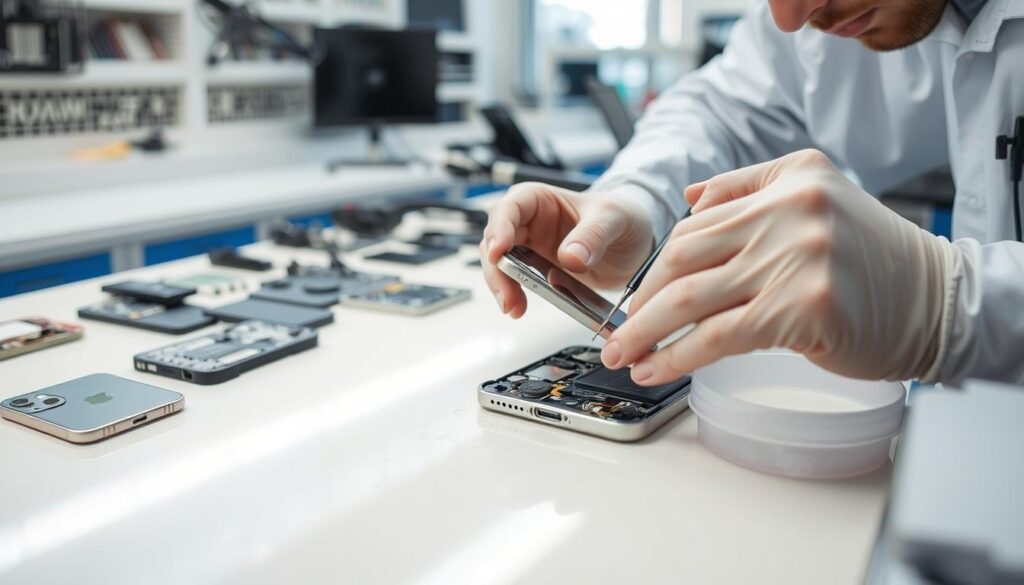
Risk Factors in DIY Repair
Fixing it yourself can be risky. Without the right skills and tools, you might make things worse. For example, using a hair dryer to dry your iPhone can hurt its inside parts. Also, don’t charge your iPhone until it’s dry to avoid short circuits. For more on water resistance, check out CNET’s article on iPhone water resistance.
Timeline for Making Decisions
The quicker you check the damage and decide what to do, the better. Waiting too long can cause more harm, like corrosion spreading. Usually, you have a few days to dry your iPhone before serious damage happens. If you’re not sure what to do or how bad it is, get professional help right away.
Preventing Future Water Damage
Preventing water damage is key to keeping your iPhone safe. Accidents can still happen, but you can lower the risk. We’ll look at ways to protect your iPhone from water damage.
Waterproof Cases and Accessories
Getting a waterproof case is a smart move to protect your iPhone. These cases add an extra layer of protection against water. Look for a case with a high IP rating for the best protection.
There are also waterproof pouches and bags for extra protection near water. For example, a waterproof pouch is great for beach or pool days.
Water Resistance Ratings Explained
It’s important to know about water resistance ratings. The IP rating system shows how well a device can handle solids and liquids. For example, an IP68 rating means it’s dustproof and can handle water.
Always check the manufacturer’s specs for how long and how deep your iPhone can handle water.
Lifestyle Adjustments for iPhone Protection
Changing your lifestyle can also help protect your iPhone. Be careful when using your iPhone near water. Avoid using it in the bathroom or near pools.
Also, check your iPhone’s seals and ports often. This can help spot problems before they get worse. For more tips, check out this guide on saving your iPhone after water exposure.
By using waterproof accessories, understanding ratings, and making lifestyle changes, you can greatly reduce water damage risks to your iPhone.
iPhone Water Resistance by Model
iPhone water resistance has improved over time. Each model offers different levels of protection. Knowing your iPhone’s water resistance is key to using it safely near water.
IP Ratings Explained
The IP rating shows how well a device resists dust and water. For iPhones, it has two numbers. The first number is for dust, and the second is for water. For example, an IP68 rating means your iPhone can handle dust well and water up to a meter deep.
IP Ratings Breakdown:
| IP Rating | Dust Protection | Water Protection |
|---|---|---|
| IP67 | High | Immersion up to 1 meter |
| IP68 | Very High | Immersion beyond 1 meter |
Water Resistance Capabilities by iPhone Generation
Water resistance varies among iPhone models. For instance, iPhone 7 and later have some water resistance. But, the iPhone 12 series and later have a higher IP68 rating, offering better water protection.
“Apple’s iPhone water resistance has significantly improved over the years, but it’s not a guarantee against water damage.”
Water Resistance Limitations and Degradation Over Time
Water resistance isn’t permanent and can decrease over time. Normal wear and tear, chemicals, physical damage, or aging can harm the seals. This makes your iPhone more vulnerable to water.
To keep your iPhone water-resistant, avoid unnecessary water, chemicals, or extreme temperatures. Regular checks and protective cases can also help maintain its water-resistant features.
Common Mistakes to Avoid When Drying Your iPhone
If your iPhone got wet, knowing what not to do can help it survive. Trying to dry it can lead to mistakes that harm it. It’s important to avoid these errors.
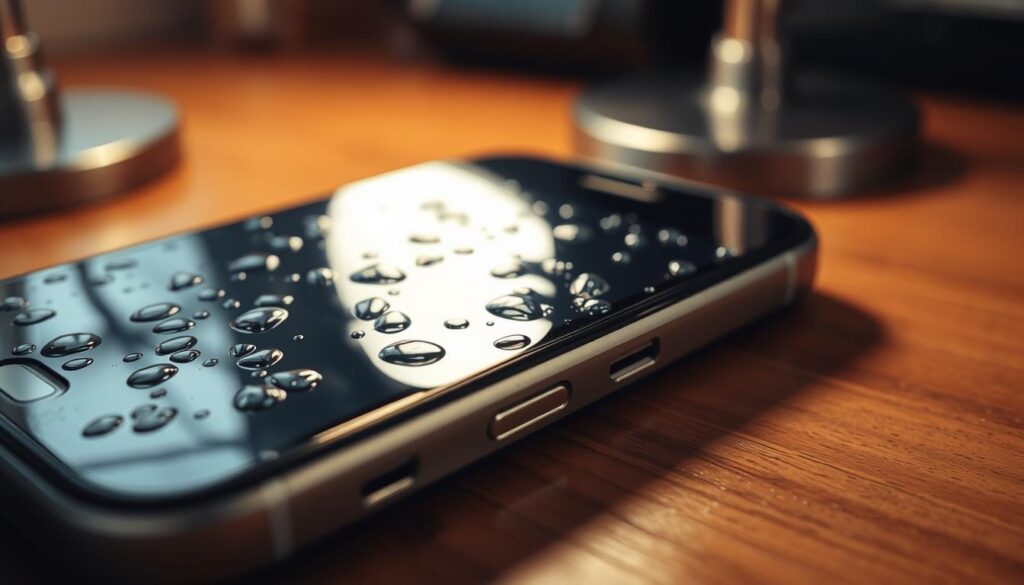
Heat Sources and Hair Dryers
Using heat or hair dryers to dry your iPhone is a big mistake. Heat can damage the inside parts of your phone, causing corrosion or warping. It’s better to let it air dry naturally.
Powering On Too Soon
Turning on your iPhone before it’s dry can cause a short circuit. This can lead to more damage. Wait until you’re sure it’s dry before turning it on.
Charging Before Fully Dry
Charging a wet iPhone is another mistake. Moisture and electricity are dangerous together. They can damage your phone’s internal parts.
Shaking or Excessive Movement
Shaking or moving your iPhone too much can push water inside. This can cause more damage. Handle a wet iPhone gently.
Avoiding these mistakes can help your iPhone recover from water damage. If you’re not sure what to do, getting professional help is a good idea.
Conclusion
Getting your iPhone back after water damage needs quick action and the right steps. This article guides you on how to do it. Start by turning off your iPhone and removing accessories. Then, use built-in features and drying methods to help.
Knowing how to remove water from your iPhone is vital. Techniques like sound frequencies for speaker water or drying charging ports are helpful. For serious damage, getting professional help is key.
Preventing water damage is also important. Use waterproof cases and know your iPhone’s water resistance. Making lifestyle changes can also protect your device. Being proactive and informed helps keep your iPhone working well.
FAQ
How do I know if my iPhone has water damage?
Look for the water damage indicator, often in the SIM card tray or on the logic board. If it’s red or pink, your iPhone has been exposed to water. Also, check for corrosion, water spots, or malfunctioning parts.
Can I fix water damage on my iPhone myself?
Yes, you can try to fix water damage on your iPhone. Follow drying techniques, use desiccants, or try water ejection methods. But, if the damage is severe, it’s best to get professional help.
What is the best way to dry out my iPhone?
Dry your iPhone with air, desiccants, and proper positioning. Avoid using heat or shaking it, as this can harm your device.
How can I remove water from my iPhone’s speakers?
Use sound frequencies or speaker drainage techniques to remove water. There are also water ejection apps that can help.
Is the rice method effective in drying out my iPhone?
The rice method can help, but it’s not the most reliable. Silica gel or desiccants are better at removing moisture from your iPhone.
Can I charge my iPhone after it’s been exposed to water?
No, don’t charge your iPhone until it’s completely dry. Charging a wet iPhone can cause short circuits and damage.
How can I prevent future water damage to my iPhone?
Use waterproof cases and accessories. Understand your iPhone’s water resistance ratings. Also, avoid exposing your iPhone to water.
What is the difference between water resistance and waterproofing?
Water resistance means your iPhone can handle some water, but it’s not fully waterproof. Waterproofing means your iPhone is sealed against water, which is not true for any iPhone model.
Will AppleCare+ cover water damage to my iPhone?
Yes, AppleCare+ covers accidental damage, including water damage. You might need to pay a service fee for the repair.
How do I file a water damage claim with Apple?
File a water damage claim with Apple by contacting Apple Support, visiting an Apple Store, or calling Apple directly. Be ready to provide your iPhone’s serial number and details about the incident.

